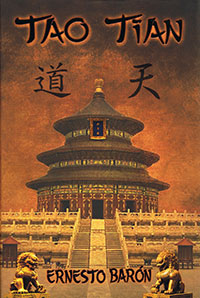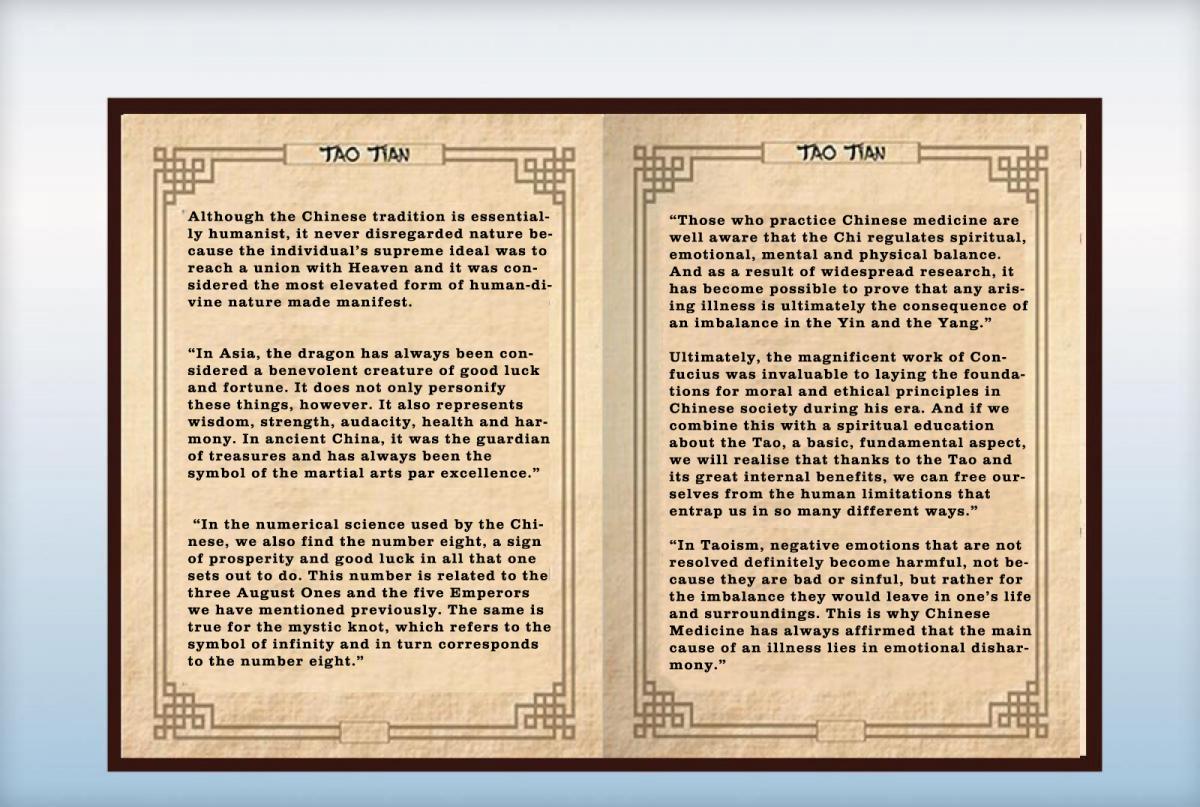Extracts "Tao Tian"
- font size decrease font size increase font size
The author, renowned writer Ernesto Barón, describes this enigmatic, ancestral culture.

Although the Chinese tradition is essentially humanist, it never disregarded nature because the individual’s supreme ideal was to reach a union with Heaven and it was considered the most elevated form of human-divine nature made manifest.
“In Asia, the dragon has always been considered a benevolent creature of good luck and fortune. It does not only personify these things, however. It also represents wisdom, strength, audacity, health and harmony. In ancient China, it was the guardian of treasures and has always been the symbol of the martial arts par excellence.”
“In the numerical science used by the Chinese, we also find the number eight, a sign of prosperity and good luck in all that one sets out to do. This number is related to the three August Ones and the five Emperors we have mentioned previously. The same is true for the mystic knot, which refers to the symbol of infinity and in turn corresponds to the number eight.”
“Those who practice Chinese medicine are well aware that the Chi regulates spiritual, emotional, mental and physical balance. And as a result of widespread research, it has become possible to prove that any arising illness is ultimately the consequence of an imbalance in the Yin and the Yang.”
Ultimately, the magnificent work of Confucius was invaluable to laying the foundations for moral and ethical principles in Chinese society during his era. And if we combine this with a spiritual education about the Tao, a basic, fundamental aspect, we will realise that thanks to the Tao and its great internal benefits, we can free ourselves from the human limitations that entrap us in so many different ways.”
“In Taoism, negative emotions that are not resolved definitely become harmful, not because they are bad or sinful, but rather for the imbalance they would leave in one’s life and surroundings. This is why Chinese Medicine has always affirmed that the main cause of an illness lies in emotional disharmony.”
“The bamboo is one of the best symbols of Taoism, it also represents maximum flexibility, resistance and extreme elasticity. Lao Tse teaches that we must be like bamboo, so that we will become incorruptible, since the bamboo can bow and bend a great deal, but, strangely, it is very difficult to break.”
“Thus, we can better understand why Lao Tse—when he came into this world more than 2,500 years ago—primarily dedicated his great mission to the philosophy of not thinking, the development of intuition and the celestial mystical sphere. That of Confucius, on the other hand, was more focused on human values, morality, ethics and all types of behavioural norms and principles.”
“We must mention that, in reality, the surprisingly prodigious Tao Te Ching is the doorway or intermediate space that lies between the physical and spiritual world—between internal and external information. Ultimately, it is the connective bridge that is indispensable for dementalising ourselves and, with supreme courage, crossing to the other side of the supreme portal-bridge.”
“There has always been this requisite for finding the Path-Tao. Undoubtedly, we are referring to the work on one’s self, including the psychological infirmities and egos that form part of this work.”
“In the Chinese Taoist tradition, meditation is a state of continuous attention focused on how the mind thinks and how we experience feelings. It is also that constant state of physical relaxation-Fang Song. We are dealing with a stable, persistent discipline that must accompany us throughout the day, and not to a sporadic practice included among our daily duties.”
“The reality of the Tao is all that exists and does not exist. Any lack of definition or vagueness that may arise is cause for distress since it departs from the beginning-origin and the effect-conclusion. This is why it has always been said that the Tao is the cause without cause, the beginning and the end of all that exists, but it is neither confusion nor bewilderment, it is clarification and coherence-harmony.”








